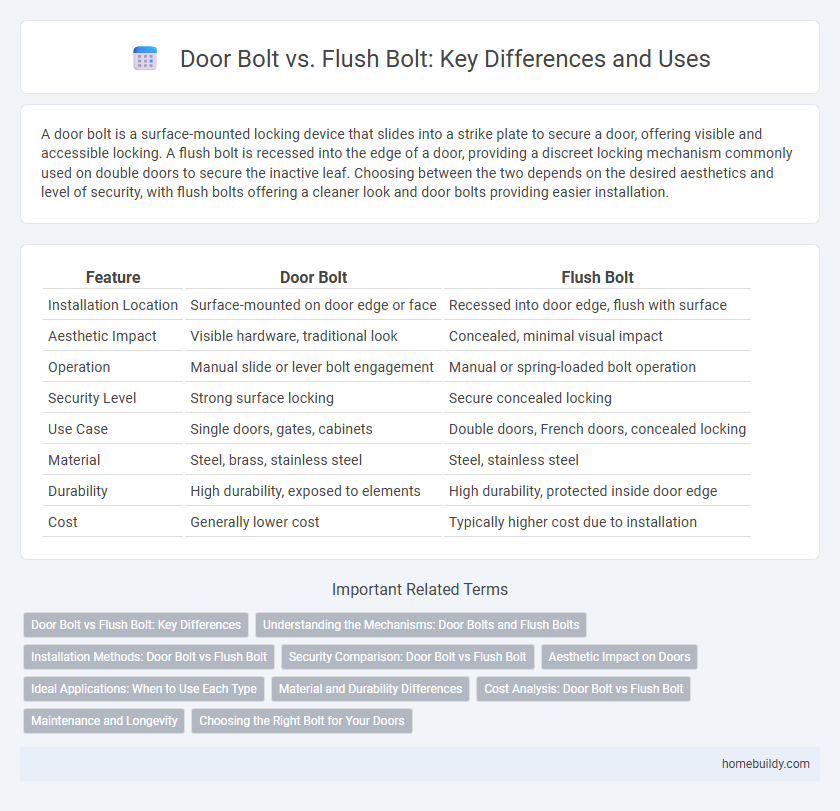A door bolt is a surface-mounted locking device that slides into a strike plate to secure a door, offering visible and accessible locking. A flush bolt is recessed into the edge of a door, providing a discreet locking mechanism commonly used on double doors to secure the inactive leaf. Choosing between the two depends on the desired aesthetics and level of security, with flush bolts offering a cleaner look and door bolts providing easier installation.
Table of Comparison
| Feature | Door Bolt | Flush Bolt |
|---|---|---|
| Installation Location | Surface-mounted on door edge or face | Recessed into door edge, flush with surface |
| Aesthetic Impact | Visible hardware, traditional look | Concealed, minimal visual impact |
| Operation | Manual slide or lever bolt engagement | Manual or spring-loaded bolt operation |
| Security Level | Strong surface locking | Secure concealed locking |
| Use Case | Single doors, gates, cabinets | Double doors, French doors, concealed locking |
| Material | Steel, brass, stainless steel | Steel, stainless steel |
| Durability | High durability, exposed to elements | High durability, protected inside door edge |
| Cost | Generally lower cost | Typically higher cost due to installation |
Door Bolt vs Flush Bolt: Key Differences
Door bolts offer a surface-mounted locking mechanism that slides into a visible keeper, providing easy installation and added security on entry doors. Flush bolts are recessed into the door edge, offering a concealed locking solution primarily used on double doors to secure inactive panels. The key differences lie in their installation method, visibility, and typical application, with door bolts favoring surface mounting and flush bolts ensuring a flush, hidden fit.
Understanding the Mechanisms: Door Bolts and Flush Bolts
Door bolts operate by sliding a metal rod into a strike plate on the door frame, providing a secure locking mechanism typically visible on the surface. Flush bolts are recessed into the door edge, offering a concealed locking solution often used on double doors to secure the inactive leaf. Understanding these mechanisms highlights that door bolts prioritize ease of use and visibility, while flush bolts focus on discreet security and aesthetic integration.
Installation Methods: Door Bolt vs Flush Bolt
Door bolts are surface-mounted on the door frame or edge, requiring screws for installation, which offers straightforward access for maintenance and adjustments. Flush bolts, embedded into the door edge, demand precise mortising to fit flush within the door, providing a sleek appearance but requiring more advanced carpentry skills for proper installation. The choice between door bolt and flush bolt installation depends on aesthetic preferences and door construction compatibility.
Security Comparison: Door Bolt vs Flush Bolt
A door bolt offers enhanced security by providing a stronger and more visible locking mechanism, typically installed on the surface of the door for easy engagement. Flush bolts are recessed into the door edge, offering a sleeker appearance but generally less resistance to forceful entry due to their concealed and smaller locking components. For maximum protection, door bolts are preferred in scenarios demanding robust security, while flush bolts are suited for aesthetic integration with moderate security needs.
Aesthetic Impact on Doors
Door bolts provide a visible, robust locking mechanism that often complements traditional or rustic door designs with their prominent hardware presence. Flush bolts, by contrast, are recessed into the door edge, offering a sleek and minimalist appearance that preserves the door's clean lines and modern aesthetic. Choosing between door bolts and flush bolts significantly influences the overall visual impact, with flush bolts favored in contemporary interiors for maintaining unobtrusive security.
Ideal Applications: When to Use Each Type
Door bolts are ideal for securing exterior doors where maximum hold and visible locking are priorities, commonly used on entry gates and heavy-duty doors. Flush bolts are best suited for double doors or French doors, providing discreet locking for one inactive leaf without disrupting the door's aesthetic. Choosing between them depends on whether the focus is on robust security with an external mount or a sleek, concealed mechanism for interior use.
Material and Durability Differences
Door bolts are commonly made from solid brass, stainless steel, or zinc alloy, offering high resistance to corrosion and wear, ensuring long-lasting durability in external and internal applications. Flush bolts typically use similar materials but prioritize lightweight aluminum or steel to fit discreetly within door edges, which may slightly reduce their durability compared to traditional door bolts. The choice of material directly influences the longevity and strength of the locking mechanism, with door bolts generally providing enhanced sturdiness for heavy-duty security needs.
Cost Analysis: Door Bolt vs Flush Bolt
Door bolts typically cost less than flush bolts due to their simpler surface-mounted design and easier installation process. Flush bolts, being recessed into the door, require more labor and precise fitting, increasing both material and installation expenses. Choosing between door bolts and flush bolts hinges on balancing budget constraints with desired aesthetics and functionality.
Maintenance and Longevity
Door bolts require regular lubrication and inspection to prevent rust and ensure smooth operation, contributing to extended longevity. Flush bolts, recessed into the door edge, tend to collect less dust and debris, reducing maintenance needs. Proper installation and periodic cleaning significantly improve the lifespan of both door bolts and flush bolts, enhancing security and functionality.
Choosing the Right Bolt for Your Doors
Selecting the appropriate door bolt depends on the door type and security needs, with surface-mounted door bolts offering easy installation and visible deterrence, while flush bolts are recessed for a sleek appearance and commonly used on double doors. Door bolts provide robust locking for exterior doors, whereas flush bolts are preferred for aesthetic integration on interior door panels. Evaluating factors such as door material, usage frequency, and desired security level ensures the best choice between door bolt and flush bolt options.
Door bolt vs flush bolt Infographic

 homebuildy.com
homebuildy.com